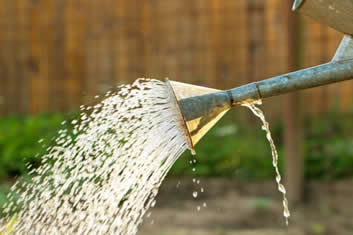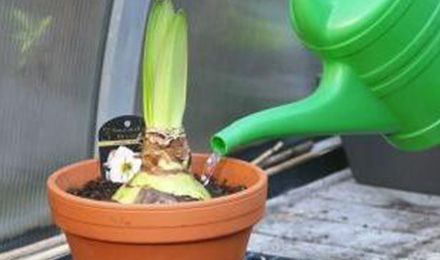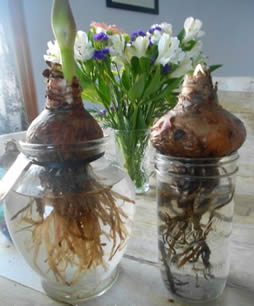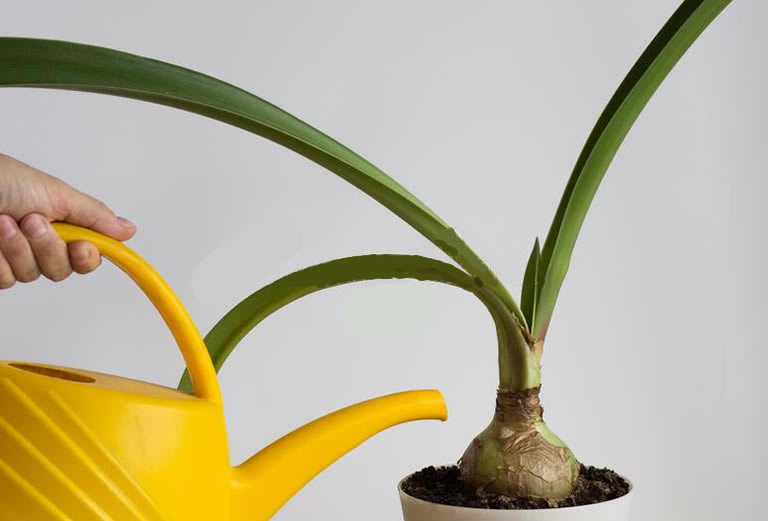In this article I outline everything you need to know about amaryllis and water. I cover when to water your amaryllis, in both the bulb stage and the fully grown plant stage as well as all the stages in between. I also outline how you should water amaryllis during its growth stages and how much water you should give the plant at each stage. I also touch on the subject of growing amaryllis in water.
Table of Contents
- This is the only amaryllis watering guide you’ll never need
This is the only amaryllis watering guide you’ll never need
Amaryllis is a tropical and subtropical succulent that requires warmth to grow. It is therefore only suitable as an outdoor plant in USDA climate zones 9 through 11 (though it can be grown in USDA climate zone 8 with proper precautions).
This means that about 90% of amaryllis grown in America is grown indoors. 100% of amaryllis grown in the UK is grown indoors as the UK simply does not have the climate capable of sustaining this plant.
So, as amaryllis is mostly grown in the US as an indoor plant, the information in this article applies to indoor amaryllis only.
If you require information on the watering requirements of outdoor amaryllis read my detailed guide to using amaryllis outside.
So, let’s begin with the most common questions.
Ending the debate about watering amaryllis from the top or bottom
Some plants prefer to be watered from the bottom while others prefer to be watered from the top. Do you water amaryllis from the top or bottom?
You should water amaryllis from the the top.
Amaryllis should not sit in water-drenched soil as this will often lead to fungal growth and other problems.
Therefore watering from the bottom is not recommended.

Unlike other succulents, such as aloe plants that need watered from the bottom, amaryllis should be watered from the top.
When you should water an amaryllis plant
Now that you know how to water your plant you will want to know when to water amaryllis.
You should water amaryllis when the top layer of soil dries out. Only the top 2 cm of soil should be allowed to dry.
You can use your finger to gauge this.
An amaryllis in an average household will therefore usually need watered at least once per week.
Bear in mind that this “once per week” guideline for watering amaryllis is a very rough guide.
Your specific plant may require more watering or less watering.
When watering amaryllis it is especially important to keep in mind that the soil should be kept moist but not drenched.
For this reason it is best to test the soil for moisture content until you have become accustomed to your plant’s watering needs.
Using my simple “finger test” you can easily gauge the moistness of the soil.
Use the finger test to check soil moisture levels
Stick your index finger into the plant soil up to the first knuckle, about 2 cm.
If the soil is moist your finger should come out of the soil with dirt on it.

Even slight dirt is an indication that the soil is moist and has sufficient water for your amaryllis.
However, if your finger comes out of the soil free of dirt then the soil is too dry and need to water your plant.
The best time to start watering your amaryllis
I often hear indoor gardeners asking the same question, “when should I start to water amaryllis?
You should start to water amaryllis when the bulb leaves the stage of dormancy.
New shoots will appear on the bulb indicating a new growth stage has begun.
If no new growth appears after 2 – 3 months of dormancy you should water an amaryllis bulb to force new growth.
During the growth stage the plant should be watered regularly.
Amaryllis is a thirsty plant, especially for a succulent. So, it requires regular watering throughout its entire growth stages.
The only time amaryllis should not be watered is when the bulb goes into a rest period and goes dormant for a few months.
You will know dormancy is beginning because the leaves will start to turn yellow (note that a drooping of the leaves is not the same thing and has a different cause).
When you should water an amaryllis bulb after dormancy
Fully growing amaryllis plants with foliage and flower stalks will obviously require more water than a naked bulb.
So, when should you water an amaryllis bulb?
An amaryllis bulb should be watered at the end of dormancy.
Watering the bulb will help trigger new growth.
The bulb should also be watered when the top 2 cm of the soil dries out. An amaryllis bulb should never be watered when it is in a dormant phase.
Apart from refraining from watering an amaryllis bulb when it is resting, during the 2 – 3 month dormancy phase, your watering routine for an active bulb should be the same as it is for a fully grown plant.
Obviously, a naked bulb will have lower water requirements that a fully grown plant with foliage and blooms so you will need to water a bulb much less often.
The only way to determine when you should water the bulb is to check the top layer of soil. Refer to “the finger test” I explained above for determining whether the soil needs to be watered.
Although a general rule-of-thumb states that you should water amaryllis once per week the exact watering routine of your specific amaryllis will greatly depend on the size of pot, the temperature and the location of your plant.
This is why I recommend you keep an eye on the soil’s moistness level until you become familiar with your plant’s watering requirements.
Just as you will do with a fully grown amaryllis plant, you should also test the moisture in the soil of a naked bulb.
Use the finger test I mentioned above to check the soil for moisture. Stick your index finger into the soil to a depth of about 2 cm. This is roughly from the tip of your finger to the first knuckle bend.

When you remove your finger there should be some residue on your finger indicating that there is moisture in the soil.
If your finger comes out completely clean then there is not enough moisture in the soil and you need to water the bulb – as long as it is dormant.
Remember, never water a dormant bulb as you will stimulate new growth and deprive the bulb of much-needed rest.
Read my guide on what to do with amaryllis bulbs after they bloom for more information.
How often you should water your amaryllis
The time-frame between waterings for amaryllis can be tricky for new indoor gardeners. They often want a set-in-stone water routine that they can follow easily and without much thought. Unfortunately, this does not exist especially where amaryllis is concerned. So, how often should you water amaryllis?
You should water amaryllis regularly. Your watering routine will depend on the pot size, the environmental temperature and the growth stage of the plant.
As a general rule you should water amaryllis when the top 2 cm of soil dries out.
This keeps the soil moist but not drenched.
As I already mentioned a bulb just entering a new growth stage requires much less watering than a fully grown plant that is about to bloom.
Although you may be tempted to just keep pouring water over your amaryllis regardless of what growth stage it is in this is not advised.
Until you have come to a point where you know your plant’s specific watering needs, and definitely in the beginning stages of plant growth, always use the finger test on the soil.
Only water an amaryllis when the top 2 cm of soil is dry.
How often you should water an amaryllis bulb that is grown in rocks
Amaryllis grown in glass jars, on a bed of rocks, only have water to supply their nutritional needs.
Therefore it is important to ensure the bulb has enough water to continue its foliage growth.
Ensure the water level for amaryllis growing in rocks does not fall below approximately 1 ” underneath the bottom of the bulb.
The roots should be able to reach the water to draw up moisture and their length will help you gauge the correct water level.
Check the plant daily to ensure the water level remains constant.
Again, I do not recommend you grow amaryllis in this way as your bulb will last decades if grown in a proper potting mix, while it will survive only one season growing in a rocky water medium.
How much water an amaryllis needs
Amaryllis may be a thirsty plant but it doesn’t like to sit in water! So how much water does it need?
Amaryllis needs enough water to wet the soil. The pot should have sufficient drainage to allow the water to pass through.
Use enough water so the top layer of the soil is damp but not drenched.
Drenching amaryllis will lead to a whole host of problems.
So, you should only water your amaryllis when the top layer of soil dries out and only give it enough water to ensure the top layer remains damp when you finish watering.
This keeps the soil moist enough to supply the plant with water to grow but makes sure it is not so drenched that it experiences fungal buildup and other diseases.
Use the finger test I mentioned above to test the soil for moistness.
It won’t take long before you know the watering requirements of your specific plant and can easily tell by just looking at the soil whether you need to give your amaryllis a drink of water or not.
Guide to growing amaryllis in water
I have already mentioned that amaryllis does not like to sit in water-drenched soil so how come you often hear about amaryllis being grown in water.
Can amaryllis grow in just water?
Amaryllis can grow in just water as long as the bulb does not touch the water directly.
The bulb is placed on top of small rocks or pebbles, usually inside a glass jar.
The water level is kept at about 1 ” below the bottom of the bulb where the roots can access it but the bulb itself does not touch it.
I do not recommend growing amaryllis in just water as it has major drawbacks.
Strictly speaking the amaryllis is not actually growing in the water as the water level is kept well below the actual bulb.
However, water is the only growing medium the plant has.
If you decide to try this way for growing amaryllis I suggest adding a floral feed, that is usually used for cut vase flowers, to the water daily so the bulb is receiving some form of nutrients.
There is a major drawback to growing amaryllis in water and it is because of this that I recommend not growing amaryllis in this way.

Amaryllis is a perennial that can live for many decades and it will bloom every year when it is grown in a nutrient-rich medium.
On the flip side, amaryllis grown in water will last only 1 season and will fail to bloom again.
In addition, it will produce limited flowers, during its one and only bloom, compared to a pot grown plant.
So, I really don’t recommend you use this approach especially when a potted amaryllis doesn’t take up any more space than a water-grown one.

